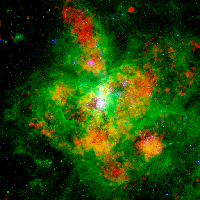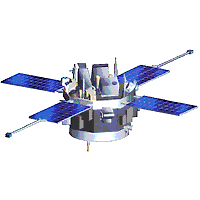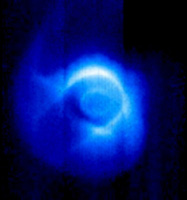
Ask Us
Space Physics:
Matter in Space
| Matter in Space |
| Speed in Space |
| Acceleration and Velocity in Space |
| Density of Matter in Space |
| Friction in Space |
| Matter in Space and the Strong Force |
| Torque in Space |
| Shock Waves in Space |
Matter in Space
I have come across conflicting information. I have read there is no matter at all in space, and also that most of the gas in space is hydrogen and helium. I'm guessing that the hydrogen and helium are found in space within galaxies, and no matter is between galaxies (what about dark matter?). Please explain!There is matter spread all through the Universe, it is just spread very, very, very, very thin. The average density of gas in our Milky Way galaxy is about one atom per cubic centimeter. This is a much better vacuum than is obtained in a laboratory, but when integrated over the Galaxy, comes out to quite a lot of mass. This gas is mostly hydrogen (~90%), and helium (~9%), and less than one percent everything else. The gas between galaxies is even thinner, but there is probably something there (it hasn't been measured, though). These elements are in the Earth because they were present when the gas cloud that formed our solar system collapsed to form the Sun and the planets.
The amount of dark matter is very much in question. From the effects of its gravity, it appears that dark matter is associated with galaxies, but extends further than the visible matter (stars). From the dynamics of galaxies in galactic clusters and superclusters, it looks like there is dark matter between the galaxies as well.
Dr. Eric Christian How do we know that space is a vacuum if nothing has ever been there to measure it?
We can tell that most of the Universe is a vacuum because matter absorbs and scatters light. We can accurately measure the amount of material between us and stars, and that gives an average density of gas in the Galaxy of only one atom per cubic centimeter. That's a better vacuum than we can achieve in a laboratory.
Dr. Eric Christian
Speed in Space
If speed equals distance multiplied by time, is there really such thing as "speed" in space? Time is a man-made unit of measure based on a terrestial observation, and so are units to measure distance! If speed exists, can one reach zero speed or acceleration in space and literally watch Earth fly by?The speed of an object is how much its position changes in a given amount of time. As long as we can measure a position and a time, we can define a speed, whether that object is on the Earth or far out in space. Distance and time do exist outside the Earth, in fact, they are a fundamental part of the "fabric" that makes up the Universe.
Humans have personally studied the motion of objects (including themselves) in Earth orbit and on the Moon. Spacecraft have been to the surface of Mars, Venus, asteroids, comets, and have flown by all but one of the nine planets. The Voyager spacecraft are now outside the solar system and are still being tracked to monitor their positions and speed. With large arrays of telescopes we have detected planets orbiting other stars, the motion of other galaxies swirling around their cores, and clustering of galaxies together. In every case, right out to the very edge of what we can observe, distance, time, and speed seem to work everywhere in the Universe just the way they do here on Earth. The units we use to measure distance and time are made up (an inch could have been defined twice as long, for example) but the distance or time itself does not depend on us.
So can we "reach zero speed"? The speed of an object is always measured "relative to" the speed of something else (hence the term "relativity"). For instance, if I sit at a railroad crossing and watch a train go by, I might measure the speed of the train as 50 miles per hour. On the other hand, if I'm in a car moving alongside the train at 45 miles per hour then the speed of the train will only appear to me to be 5 miles per hour. (When you get near the speed of light things start to behave a little differently but that's another story, Einstein's "special" relativity). The point is that we always measure speed with respect to some particular frame of reference.
As it turns out, there doesn't seem to be any absolute frame of reference in the Universe. Earth moves around the Sun, the Sun moves through the arm of the Milky Way galaxy, the arm spirals around the core of the Galaxy, our galaxy moves inside our local group, and so on. A few theorists may argue that there is some frame of reference against which all motion can be measured, but even that should tell you that if such a frame exists, it is not obvious. So for our purposes, if you want to watch the Earth fly by, all you have to do is get yourself moving the other way at whatever speed you want to see the Earth go by.
One thing you could imagine doing is to launch a spacecraft to orbit the Sun in the opposite direction that the Earth goes around. If you got the spacecraft going the other way at the same speed as the Earth, you would be "at rest" from the point of view of the solar system. Then you could sit there and watch the Earth go around the Sun and come back to you every year (you'd want to move over a little so it doesn't run into you when it comes around again). So that might be "zero speed" with respect to the Earth's motion around the Sun, but not compared to another planet's motion or the Sun's motion through the galaxy.
Dr. Jeff George
(April 2003)Acceleration and Velocity in Space
It's my understanding that if a space-going vessel continued to burn its engines non-stop, then regardless of the power of the engines (or the fuel used) the vessel would continue to accelerate until the fuel ran out. Then it would coast at a constant speed. A friend said that this is incorrect and that each fuel used in space has a maximum speed, and that once that speed is attained the vessel will be at a constant speed, even if the engines are on continuously. Which is true?The short answer is, "You're right and your friend is wrong."
This question was answered by Newton when he concluded that acceleration (and not velocity) was proportional to the force applied to an object. Another of his laws was that once set in motion (such as when a spacecraft is coasting after burning its fuel), the object travels in a straight line at a constant speed unless acted upon by another force.
Probably the greatest reason for misunderstanding this aspect of classical physics is the modern car. We know that to drive at a constant speed we need to burn fuel. What we forget is that a moving car experiences friction in the form of air resistance. The soft tires also consume energy as they flex and turn. The fuel burned in the engine is overcoming those forces to allow the car to move at a constant speed.
Newton would have loved space. There is no air resistance. There is only gravity. Once a spacecraft is accelerated to a given speed, the engine is turned off and the craft coasts forever with its trajectory affected only by the force of gravity.
The best example of this I know is the Voyager 1 & 2 spacecraft. They were launched in 1977 and went to Jupiter and Saturn. Voyager 2 went on to Uranus and Neptune. Their trajectories were affected by gravity during their swings past the planets, but they continue to coast ever outward. Today they are nearly 90 times as far from the Sun as is the Earth and probing the region where space dominated by our Sun meets interstellar space. And on they coast, not burning any fuel. They move at a constant velocity, looking, recording, and teaching us more every day.
So you see, the beauty of space is that it is really much simpler than physics here on Earth.
Dr. Charles Smith
(June 2004)Density of Matter in Space
It seems to me that with space travel, the speed of a spacecraft would be limited by the matter in space due to friction. Is this true?The density of matter in our Galaxy is about 1 particle/cm3 (in the disk, with the halo being less dense). The density of matter in intergalactic space (between galaxies) is about 2 x 10-31 gm/cm3, mainly hydrogen. At these densities, I don't think one has to worry about friction.
Dr. Louis Barbier
Friction in Space
Does friction exist in deep space?Yes, when two surfaces rub together in outer space, there will be friction. Friction is a surface effect and doesn't depend upon there being air. There is also a force like air resistance from the very sparse gas in space, but it will be very, very small, since space is a very good vacuum.
Dr. Eric Christian
Matter in Space and the Strong Force
What does it mean to say that stars burn the same throughout the Universe? Aren't some hotter than others? Isn't it true that most of the Universe is composed of plasma, i.e. an unstructured mixture of quarks and electrons WITHOUT a strong force? This was at least the case just after the Big Bang. So the strong force is/was different at different places and velocities. If I'm way off base, please direct me to a good book.Stars get their energy by fusing lighter elements into heavier elements. There are no free quarks in stars; they have electrons and nuclei right through. Saying that stars burn the same throughout the Universe means that observations of stellar temperatures and the elements present are consistent no matter where we look.
Most of the Universe IS a plasma, but a plasma is a gas of electrons and atomic nuclei, not quarks. Current theory says that you can't have a quark soup except at very high temperatures, such as right after the Big Bang. But even then, the strong force was present (as were gravity, electromagnetism, and the weak nuclear force). There are NO observations that indicate that the four basic forces of nature aren't constant throughout the Universe.
I'm not sure of any popular book that goes into this stuff, maybe one of Stephen Hawking's. Sorry.
Dr. Eric Christian
Torque in Space
We've been learning about torque and rotation, and we're told that in order for rotation to occur there must be a pair of equal and opposite forces, whose lines of action are parallel and in the same plane - a couple. Is the same true everywhere, including space?Suppose there is a long steel girder in space, and we attach a rocket to one end of the girder so the thrust from the rocket acts perpendicular to the girder. When the rocket fires, will the girder move straight forward because there is only one force and no couple? Intuitively I would think that it would rotate, but if there is no couple, how can it rotate?
Let's imagine this scenario: You have this pole of length L and mass M in space. For simplicity, you attach a massless rocket on only one end, perpendicular to the long axis of the pole. The rocket can create a thrust with a force F. Since the pole is free (not fixed to anything rigid in space), it will rotate about its center of mass. The moment of inertia I of a pole of length L and mass M about its center of mass is (M*L2)/12. You can read about the moment of inertia in most classical mechanics books. They also normally give the moments of inertia of common objects such as this.
The torque of the rocket about the center of mass of the pole is simply the force of the rocket times the distance to the center of the pole (L/2). This torque is equal to the product of the moment of inertia I of the rocket and the angular acceleration, alpha.
So...
F*(L/2) = I*alpha = (M*L2*alpha)/12
Solving for alpha:
alpha = (6*F)/(M*L)
So for a 50-meter, 100-kilogram pole and a rocket that can supply 1000 N of thrust, the pole will begin to rotate about its center of mass with an angular acceleration of 1.2 radians per second squared.
In the end, the concept of equal and opposite forces can be very misleading. You can see here that the rocket creates opposite forces in the same plane on only one side of the pole, and causes it to rotate.
Lauren Scott
(March 2004)Shock Waves in Space
How can shock waves travel through outer space when there is no air in space to carry them?Well, space is not in fact empty. It is filled with tenuous (and in some places not so tenuous) plasma. This plasma is much like our atmosphere and shock waves can in fact travel though it.
Dr. Louis Barbier
(November 2001)






Questions and comments to: cosmicopia@cosmicra.gsfc.nasa.gov
Curator: Dr Eric R. Christian, NASA
Responsible NASA Official: Dr Eric R. Christian
Privacy Policy and Important Notices

HOME
In the News
History
Ask Us
Great Links
Glossary
Site Map
Search NASA